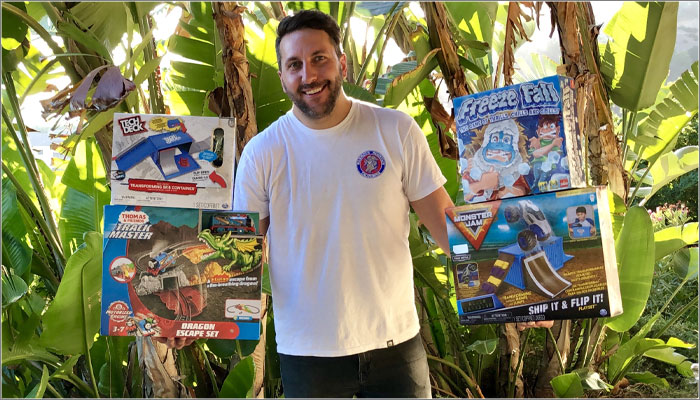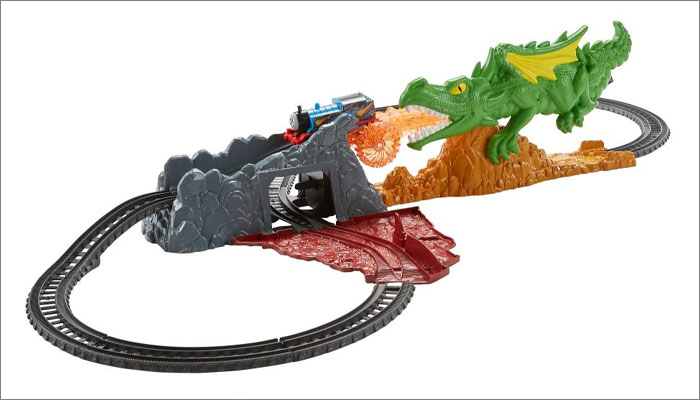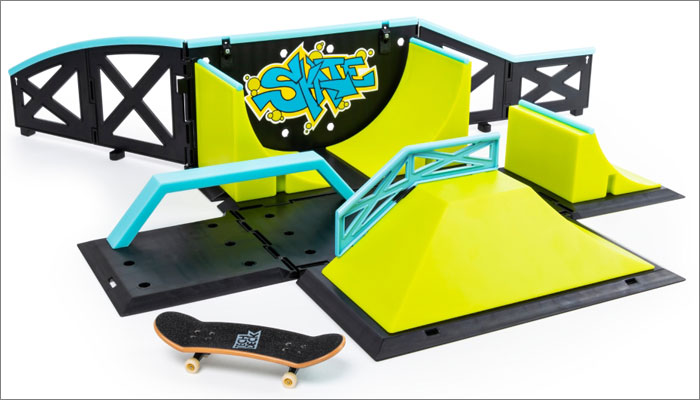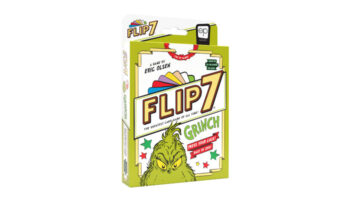Dominic Yard on why a toy designer’s best idea is to have lots of ideas

Dominic Yard is the founder of the highly regarded one-man-band invention and design studio, This is YARD.
After cutting his teeth in the world of toy design at Play On Design, and then Fuse, on brands such as Polly Pocket, Tech Deck and Hot Wheels, 2013 saw Yard go solo.
Now based in LA, Yard has forged a reputation as one of the brightest new design studios around, with recent hits including the Tech Deck Sk8 Container with Spin Master, and several fruitful collaborations with StudioPlay’s Gil Zalayet on upcoming Goliath game Freeze Fall and Thomas & Friends items like the Thomas Adventures Sea Monster Pirate Set and recent Track Master Dragon Escape Set.
We caught up with Yard to learn more about his route into the world of toy design, what advice he’d give those starting out, and what the development process was like for his new Tech Deck Sk8 Container Pro – a product for which he’s nominated for Toy Designer of the Year at next month’s Play Creators Awards.

How did you get started in the world of toy design?
Well it was a bit of a left turn!
I was always into building stuff growing up but toy design was not on my radar when I studied Product Design at Sheffield Hallam University. In the final two years of High School, I studied Design technology, geography and Physics at A-level. There was a short stint when I thought I would like to be a Geophysicist, but A: I couldn’t spell it and B: I completely failed physics! So I went with the ‘I like building stuff’ approach and chose Product Design.
I’m from Devon originally, but after University in Sheffield and a stint living in New Zealand I moved to London in 2008. I was applying for all sorts of different design jobs. I saw a job advertised in Design Week to work on Polly Pocket at Play On Design. I knew about the brand from growing up, but designing for little girls had not been anything I ever thought about!
I applied, although I was totally under qualified. My university portfolio did however consist of playful, fun concepts so it actually worked out pretty well and they gave me a shot after a small trial project!
Straight away, I was asked to make a pretty detailed model! In at the deep end, but it was awesome because It was all hand build, having to learn lots of new skills and materials on the fly!
I’d only been in the job a few weeks, and someone handed in their notice – hopefully not because of me! The firm had a trip planned to go and see Mattel in LA for a girls brainstorming session, and with a space free, they asked me to come. It was amazing to be doing all this stuff within the first month of the job!
At Play On Design we were also working on all sorts of brands, from Hot Wheels to Spin Master IP. It was a small team but a great team – Kevin Gillon, Annette Field, Emily Pugh and myself.
My first item to come out was the Polly Pocket Pop-Up Glamper Van! I also did a line of modular Hot Wheels cars with Emily. Suddenly I had stuff on the market and I could go into any toy store and see products I’d worked on. It opened my eyes to how huge the mass toy market is.

I spent two years at Play On, and then they merged with Evolve to form Fuse. I spent two years at Fuse. They gave us a lot of freedom to come up with our own new stuff. It was also great to learn the business and learn the royalty-based model. That’s when I decided to try and do this for myself.
Ultimately, I’m fiercely independent, so I wanted to try and go it alone. But, out of the blue, I was offered a job as head of design at a giftware company called Spinning Hat where I’d be managing a team and also production. I worked there for a year and I got to go out to China, which was key to understanding the production line and was all such an eye-opener.
We launched 25 new products in one year and I added my toy mechanism expertise to some of the items including a bottle opener that could open, retain the cap and then fire it across the room!
It was a great experience, but the giftware market didn’t have the same scope and excitement for me so I decided to go back into toys as an independent inventor in 2013.
I didn’t really have any money saved up or much of a plan when I decided to step off solo but again I wanted to just dive back in and get going. As soon as I launched it, I had companies asking me to come and show them stuff, and it snowballed from there. It really helped that I cut my teeth at a well-respected company like Fuse and had an established portfolio to start with.
The funny thing is after that trip to LA in 2008 in the first month of the job, I’ve now gone full circle and I’m living in Los Angeles!
How do you balance coming up with entirely original creations, versus working to a company’s brand portfolio or wishlists?
Wishlists are great, but are no way close to a blueprint for success. Generally, I try and come in with the unexpected thing because, ultimately, everyone is guessing! I’m guessing what the company wants and they’re guessing at what kids want.
You’ve got to come up with something off your own back, like a cool mechanism, and then it’s about working together to develop it. Most things I’ve created which have made it to market have involved several iterations of models that have been co-developed alongside a company. That back and forth is really important.

Where do you find you get ideas? What’s your creative process like?
It’s a boring answer! You just have to sit down and force yourself to work. 10AM to 1PM is when I’m most productive for new ideas! But you have to sit down and start. If you sit around waiting for inspiration to hit you, it won’t! It can be frustrating because I think if I’m going to spend five hours building this, I don’t want it to have been a waste of time, but you never really know what you’re going to get until towards the end of that process.
Once you get over that hump with a model and you’ve figured it out, it becomes fun and rewarding and you start to get other ideas too. But the boring answer you just have to sit down and start sketching or building stuff.
You’re nominated for Toy Designer of the Year at our Play Creators Awards this year for the Tech Deck Sk8 Container Pro. Can you talk us through the development of that product?
The Skate Container Pro is the second version of my original skate container. I did a range of Tech Deck products when I was at Fuse, and because I grew up surfing, skating and biking, I understand the action sports world really well and how a real life skate park is laid out. I also still do all those sports!
Tech Deck is all about real world stuff, so I can understand the core DNA of that brand well. When I first went solo, I went to Spin Master and wanted to pick up where I left off on the Tech Deck brand. The Skate Container was actually concept number four from starting out. I originally built it in 2013. It didn’t get picked up the first time around but two years later, they wanted to see it again and I worked with the team to refine it. It doesn’t have a big explosive feature, but it plays really well. It is super modular and gives loads of options for open ended play. It’s been my best item!

When something comes out, you can get a pretty good read on it on YouTube. If kids are playing with it on YouTube, there’s a good chance it’s doing well! I’ve watched loads of videos of kids playing with it on youtube in expected and unexpected ways! It’s a really good solid toy that kids repeatedly play with. When I send toys of mine to friends with kids, it’s the thing they play with the most.
The Skate Container Pro, coming out very soon, builds on that with an even bigger modular system. Hopefully every kid will buy the next one and build on to their existing play-set.

Tech Deck is great because it captures a really large age range from three year olds to teenagers! It was funny because myself and my friends in high school would shred our finger-boards in class. I still have little sessions on my studio desk now!
Is the industry in a good place creatively speaking?
It feels good. The companies are super open to inventors now. There’s a big outreach for new ideas, and look at what you guys are doing with the Mojo Pitch, it’s way more open now. There’s nothing stopping me from getting infront of the right people.
Everyone is scrambling for the one-off, breakout hit that in turn could become a big brand. That’s great for inventors because it means we can pitch crazy ‘one-off’ things, rather than strictly items that fit within a brand. On the flip side, back in the day you had opportunities with the trusty high-price big play-sets, but those opportunities aren’t always there today.
Overall on the concept front It still feels like 90% rejection, but that 10% keeps it exciting and keeps you coming back!
What advice would you give to a new designer looking to make it in the industry?
One of the most important things is to have lots of ideas. And you’ve got to develop a thick skin and not be precious about stuff. You’ve got to persevere with ideas, but at the same time, not be too stubborn about concepts. Be prepared to abandon ideas quickly, and you can always come back to ideas and rejig the slightly duff parts of past ideas later.
But also don’t stress that you need to have 50 ideas straight away. Have two or three, listen to feedback and take that on-board. Be honest about your lack of experience too. People will want to help you and teach you about the industry; it’s human nature. It’s nice to help people!
I still see myself as a newbie and I lean into established inventors a lot for advice. Absorb as much information as you can and throw yourself into the events, like Mojo’s Toy and Game Design Conference and the Mojo Pitch. That’s the part I like, showing people concepts and taking on the feedback.
And I’d also tell newbies to learn the ropes of the licensing route! So many designers decide to self-publish, without realising they could license concepts to toy and game companies. It’s not for everyone, but you might find licensing is a better fit for you.
























